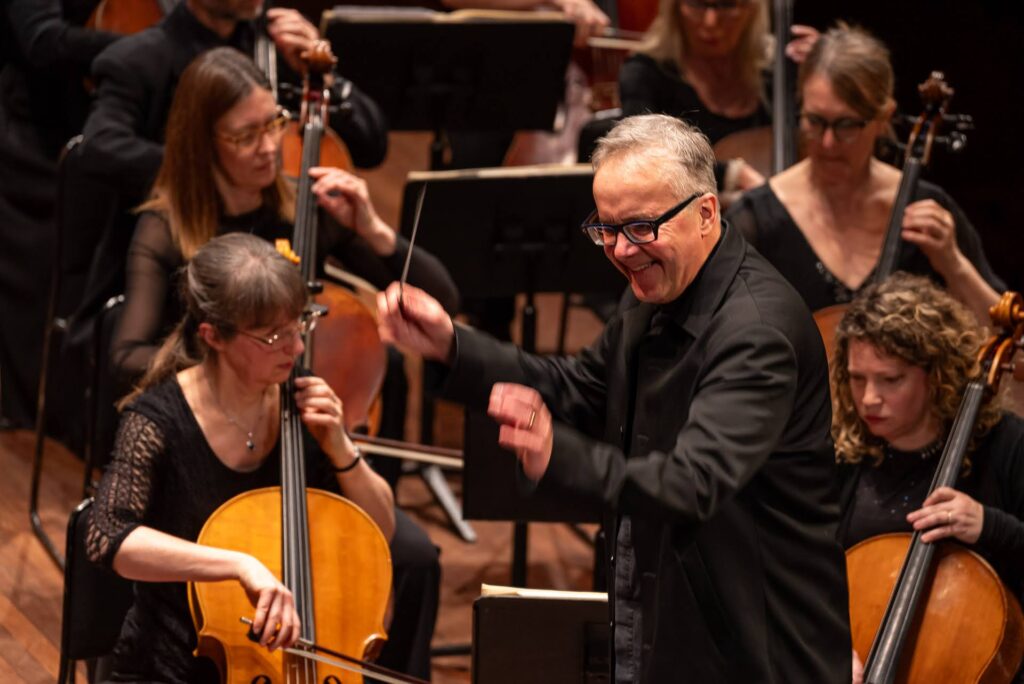 Orchestra Wellington Music Director, Marc Taddei – photo credit: Latitude Creative
Orchestra Wellington Music Director, Marc Taddei – photo credit: Latitude Creative
SERGE PROKOFIEV – Symphony No. 1 “Classical” Op.25
GERMAINE TAILLEFERRE – Piano Concerto (1924)
LUDWIG VAN BEETHOVEN – Symphony No. 9 in D Minor “Choral” Op. 125
Somi Kim (piano)
Emma Pearson (soprano), Margaret Medlyn (mezzo-soprano),
Emmanuel Fonoti-Fuimaono (tenor), Robert Tucker (baritone)
Orpheus Choir of Wellington
Orchestra Wellington
Marc Taddei (conductor)
Michael Fowler Centre, Wellington
Saturday, 6th June 2024
Orchestra Wellington’s visionary and compelling 2024 survey of concert music and some of its significant milestones certainly lived up to expectations with “The Classical Style”, a most attractive and “something for everybody” selection highlighting pieces whose composers took their inspiration from classical forms through which they were able to refract their own individuality and distinctive voices.
The highlight of the evening for me was undoubtedly the Piano Concerto by the French composer Germaine Tailleferre, a beautifully luminous and engaging piece whose relative neglect until recent times I find difficult to fathom on the strength of pianist Somi Kim’s sonorous, attractive playing and Orchestra Wellington’s gorgeously sinuous accompaniments. Also, framing this work were two far better-known but still ineffably fascinating pieces by Prokofiev and Beethoven whose “add water” appeal would have nicely eased audiences into Tailleferre’s relatively unchartered territories.
Before the concert began, maestro extraordinaire Marc Taddei took the liberty of using the occasion to promote an important new recording project involving the orchestra and himself, one paying tribute to the music of a composer whose work Taddei and the Orchestra have valiantly supported over the years, New-Zealand-Greek composer John Psathas, (born in Wellington, in 1966, to Greek parents). This is a recently-recorded two-disc (both vinyl and CD) set on the Atoll label titled “Leviathan” containing four concerti, three for percussion and one for tenor sax. (“Leviathan” is, of course the title of one of the percussion concertos). With the help of concertmaster Amalia Hall, Taddei displayed the LP set with its stunningly-contrasted coloured vinyl (one disc white and the other blue), all with the kind of “fatal attraction” allure that a vinyl-collector like myself would find impossible to resist – as with the orchestra’s previous unmissable recording project involving two Beethoven symphonies to which, of course , I readily succumbed! If this paragraph sounds like an advertisement, it’s because I simply can’t help myself at this point! – so, back to the concert! (see the conclusion of this review for details regarding the recording’s availability)….
Where was I? – Oh, yes! – one finds it difficult to think of a better choice to begin such an evening as we had scheduled than with Prokofiev’s self-proclaiming “Classical” Symphony, and in a performance which, for three of the four movements seemed to me to attain an “ideal” regarding the ever-tantalising balance in performance between surface execution and feeling. The opening movement properly launched itself upwards with great gusto, but with enough ‘wriggle-room” for the momentums to generate the piece’s infectious eagerness while allowing a flexibility of movement between the different themes.
The adorable slow movement was by turns tender, limpid, forthright and glowing – I particularly enjoyed the enticing “lift” to the triplet rhythms that accompanying a later reprise of the principal theme, and the quiet dignity with which it all ended. The Minuet I also found utterly charming, Marc Taddei allowing his players enough “expression” in their exchanges to reinforce the idea that these were real dancers, rather than simply marionettes going through the motions. After these delights I thought the finale a tad too hasty, to my mind exchanging some of the music’s deliciousness for the sake of sheer brilliance (though the orchestra certainly rose to the occasion, the wind players in particular performing miracles of fingering and tongueing in keeping up the tempo!).
French composer Germaine Tailleferre has until relatively recently been known by the musical world at large merely for her membership of the French group of composers named “Les Six”, and for little else, a similar fate to two other group members, Louis Durey and Georges Auric. Tailleferre, who had distinguished herself as a pupil at the Paris Conservatoire, and who received further encouragement from both Erik Satie and Maurice Ravel, became a member of “Les Six” in 1920. She composed a great deal during the 1920s and 30s, much of which was lost during World War Two after she had fled France for the United States – her creative output continued after her return to France up until her death in 1983, by which time she had produced almost two hundred finished works. Her 1924 Piano Concerto survived the war, becoming one of several concertante works she completed, including a Second Piano Concerto, a Violin Concerto, a Double Piano Concerto and a Double Guitar Concerto!
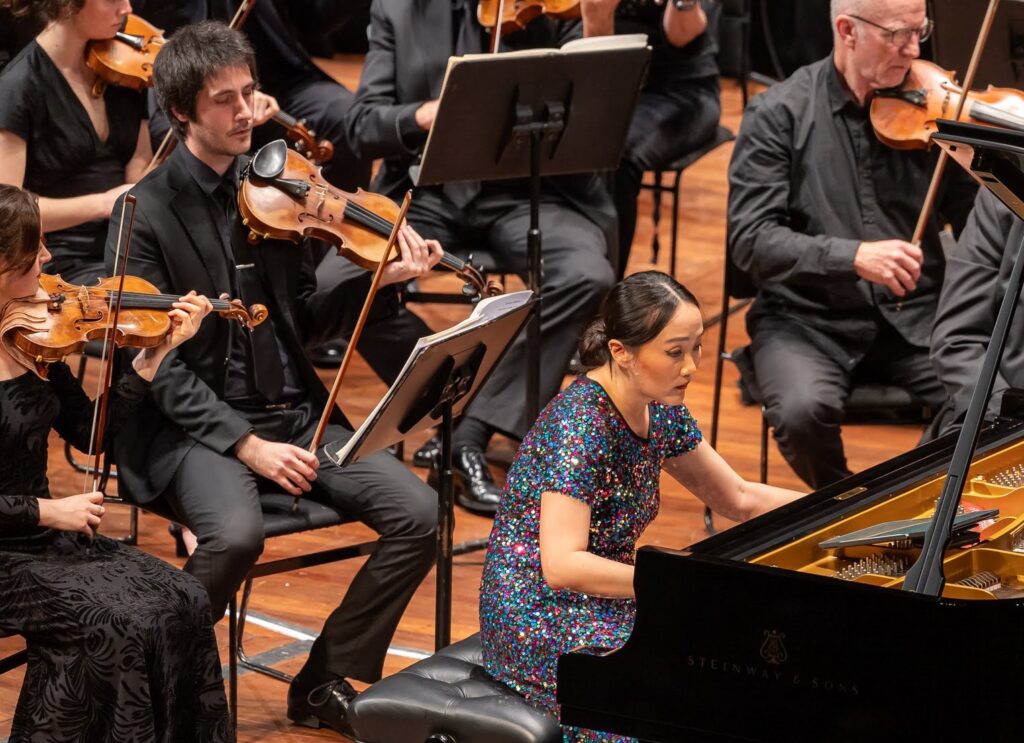 Somi Kim, piano, plays Germaine Tailleferre’s 1924 Piano Concerto with Orchestra Wellington – photo credit: Latitude Creative
Somi Kim, piano, plays Germaine Tailleferre’s 1924 Piano Concerto with Orchestra Wellington – photo credit: Latitude Creative
Though not a long work the Piano Concerto features the piano playing practically without a break, a task which the soloist Somi Kim undertook sporting a sparklingly eye-catching dress which seemed to visually echo the music’s constantly effervescing glitter throughout the three movements, and especially in the outer ones, with coruscations continually flying off in all directions!
The first movement, in lively, quick-march tempo, straightaway engendered a sense of a festive occasion, with music that seemed to be purposefully “on the move” somewhere, the playing beautifully gradated by both pianist and orchestra to a similar objective, whatever the orchestrations and however discursive the key-changes. Throughout, I was put in mind of JS Bach’s First and Third Brandenburg Concerti with their constant sprinklings of instrumentation channelled towards both the act of interchange and the establishment of a kind of overall “understanding” between the participants as a desirable and complementary process, rather than any kind of duel or contest.
The slow movement seemed the emotional “heart” of the work, with Somi Kim’s piano solo seamlessly enhanced by the winds, and Marc Taddei enjoining the strings to make the most of an ongoing sinuousness melody. The ensuing tutti took it up, buttressed by rich chordings from the piano and further warmed by a sappy trumpet solo – so much achieved, I thought, with relatively simple means! A warm-hearted oboe solo then gave way to a “worrisome” flute, bringing a forlorn note to the proceedings before the movement’ concluding surprise – a remarkably haunting and certainly unexpected modulation to distant realms right at the end!
I enjoyed the ambivalence of the finale’s opening rhythm, my ear jumping to and from different numbers of beats to the bar as the music’s trajectories evolved, keeping me guessing in delicious-sounding ways. Again, It’s all more of a concertante work than a concerto, really, a true partnership in the baroque/classical manner, rather than any kind of contest between soloist and orchestra – Kim and Taddei dovetailed their piano and orchestral parts splendidly throughout, and the solo cadenza near the end gave the pianist the chance to “sound out” a couple of beautiful church-bell-like cascades before the solo trumpet invited the rest of the orchestra back into the discourse for the work’s coda, one not unlike a gentler, more urbane version of the final bars of Shostakovich’s First Piano Concerto, with its prominent solo trumpet part! Certainly, I felt, a work to get to know better.
Somi Kim responded to the warm audience applause at the end with a lithe, nimble-fingered encore rendition of the well-known Rondo a la Turca from Mozart’s Piano Sonata K.311. I would have enjoyed as much her playing something by Poulenc or Satie or even Ravel, if only to keep up Gallic appearances, but the audience obviously loved it – so c’est bon!
After the interval, Beethoven’s Ninth Symphony might have seemed “le deluge”-like at such a concert – it was, after all, the nineteenth’s century’s most influential symphony with even its “number” becoming an insuperable burden for at least seven subsequent symphonists I know of who ventured into those same numerical realms and faltered – Schubert, Dvorak, Bruckner, Mahler, Vaughan Williams, Malcolm Arnold and Roger Sessions. Marc Taddei further stressed the significance of Beethoven’s work by talking about the composer’s simultaneous adherence to tradition (four contrasting movements, including a sonata-form opening movement, a scherzo and a slow movement) AND to the work’s ground-breaking aspects (the work’s epic length, and with a symphonic finale like no other with vocal soloists and choir!) So the work epitomised a composer’s knowledge, experience, use and further develop of this creative ethos called “The Classical Style” like no other had done up to this time.
As I’d found with his conducting of the “classics” occasionally in the past I found Marc Taddei’s very direct and at times to my ears more-than-usually brusque approach to Beethoven’s opening movement of the Ninth Symphony hard to get in accord with at first – I’d always thought of Beethoven’s opening movement as having a rugged epic grandeur which explodes in places with excitement – but Taddei’s “never-let-up” tempo made the whole movement seethe with barely-contained energy, exciting in its way, but hardly with a “epic” quality. I thought the famously seismic “middle section” of the movement, for instance, didn’t have the sheer impact I was accustomed to feeling because much of the rest of the movement had already been given so agitated a character. It certainly made me rethink what Beethoven himself might have been after – something less monumental and more kinetic and volatile, which Taddei and his players certainly put across with few holds barred and with such elan and brilliance! I did come to the end of the movement thinking “Golly! It’s over, already!” having lived for so long with more colossal-sounding traversals. This one was, for me, quite a wake-up call, and certainly an ear-opening experience!
I could far more readily equate with Taddei’s treatment of the Scherzo, the opening biting and incisive, the timpani blows galvanising and the rhythms spot-on throughout – the movement’s compelling amalgam of high spirits and restlessness was put across with incredible panache, both in an ensemble and individual sense – the timpani’s almost visceral attack was exhilarating, and the wind-and brass playing throughout the Trio sections were a joy to listen to! And I did appreciate the repeats, enabling us to enjoy that feeling of physical excitement and exhilaration for much of the piece all over again!
As with the first movement I took a bit of getting used to the quicker pulsings of the slow movement, again wanting a longer-breathed, more “epic” quality to prevail, something which, as my own rhythms “caught up” with the conductor’s, I increasingly enjoyed as the movement progressed, Taddei actually allowing the strings enough space for their phrases to bloom, and the lines to sing. The sequence with the winds and the solo horn took on a lovely glow in places (the latter player’s brief solo flourish was gorgeous!). And though I again felt the triplet variation section was overly pushed along, it was given a charm of its own by the superb playing. I didn’t like the excessively staccato treatment of the great fanfares, wanting them to have more of a “resounding” character in those celestial spaces hovering around and about the notes. In all, the movement certainly sounded beautiful playing-wise, even if I felt my listener’s usual “transfigured” sense of feeling in this music thwarted by its quicker-than usual pace…..
 Soloists Emma Pearson (soprano), Margaret Medlyn, (mezzo-soprano), Emmanuel Fonoti-Fuimaono (tenor) and Robert Tucker (baritone), with the Orpheus Choir of Wellington, Orchestra Wellington, and Music Director Marc Taddei – Photo credit: Latitude Creative
Soloists Emma Pearson (soprano), Margaret Medlyn, (mezzo-soprano), Emmanuel Fonoti-Fuimaono (tenor) and Robert Tucker (baritone), with the Orpheus Choir of Wellington, Orchestra Wellington, and Music Director Marc Taddei – Photo credit: Latitude Creative
And so to the finale! – what a magnificent “horror chord” opening utterance we got, straightaway! The recitatives then jumped out of their blocks quickly, perhaps with not enough weight to convey firstly their disapproval (instrumental versions of “O Freunde. nicht diese töne!” – O friends, not these sounds!) and then their exultation when the “Ode to Joy” melody finally appears (“O Freunde, freuden vollere!” – O friends, more joyful ones!). The orchestral basses were INCREDIBLY quiet at the beginning of their “Ode to Joy” theme, while the strings and winds partnered really well for their verses, and the brasses were simply magnificent in their utterances!
A second “horror” chord introduced the soloists – and Robert Tucker made a tremendous initial impression with his recitative, though less so with his verse, the line being low for his voice – I suddenly felt that the soloists perhaps ought to have been at the front with the conductor, and not behind the orchestra – surely Beethoven wanted them to be heard, and not just as solo choral voices! I was surprised when I realised that Margaret Medlyn was singing the alto part, and not Melissa Crennan, as per programme (I was told later that the latter had fallen ill). Generally the soloists were audible, though soprano Emma Pearson’s clear, bell-like tones stood out from the rest. The Orpheus Choir were the real heroes – great shouts of “Vor Gott” (Before God) ushered in the tenor solo, (Emmanuel Fonoti-Fuimaono), though he was hampered by the trajectories disappointingly sped up and the rhythms flattened out, leaving him almost no swagger in his step, and little room for any real heroic timbre in his voice!
I wondered why the horns sounded here as if they were “joining” their pairs of repeated notes in the brief introduction to the choir’s reprise of “Freunde, schöner Gotterfunken” (they WERE playing very softly)…..the latter was splendidly done, as was the whole “Seid umschunglen, Millionem” (Oh, you millions, I embrace you!), during which sequence I at last got a real “cosmic” sense from the music, thanks to the “space” accorded the singers by the conductor, expressing the moment’s mystical and epic gravity. Perhaps the Orpheus’s most splendid moment was the great Choral Fugue “Seid umschunglen, Millionem” which then followed, the voices and orchestral brass achieving real grandeur together!
The solo quartet’s “moment of truth” came at the end of the sequence with the choir at “Freude, Tochter aus Elysium” (Joy, Daughter from Elysium), and the “Alle menschen werde Bruder” (All men shall be Brothers) sequence, where the soloists individually rhapsodised over the words, raptly concluding with a high B-flat from soprano Emma Pearson – nicely, if a wee bit circumspectly rounded off! Then it was the famous final presto sequence, choir and soloists intoxicated with joyful feeling and racing to the work’s conclusion, with the orchestra having the final riotous say!
Away with the perfidy of critics! – all were heroes, singers, choristers, players, conductor! – and all were enthusiastically and resoundingly applauded, and the magnitude of their achievements, singly and corporately, given their just dues. I babbled about the performance highlights afterwards to anybody nearby who would listen, and gleaned from the exchanges that those present absolutely revelled in what they’d just heard, drunk with those copious dollops of “Freude, schöner Gotterfunken”, given to humankind as a gift for the ages.
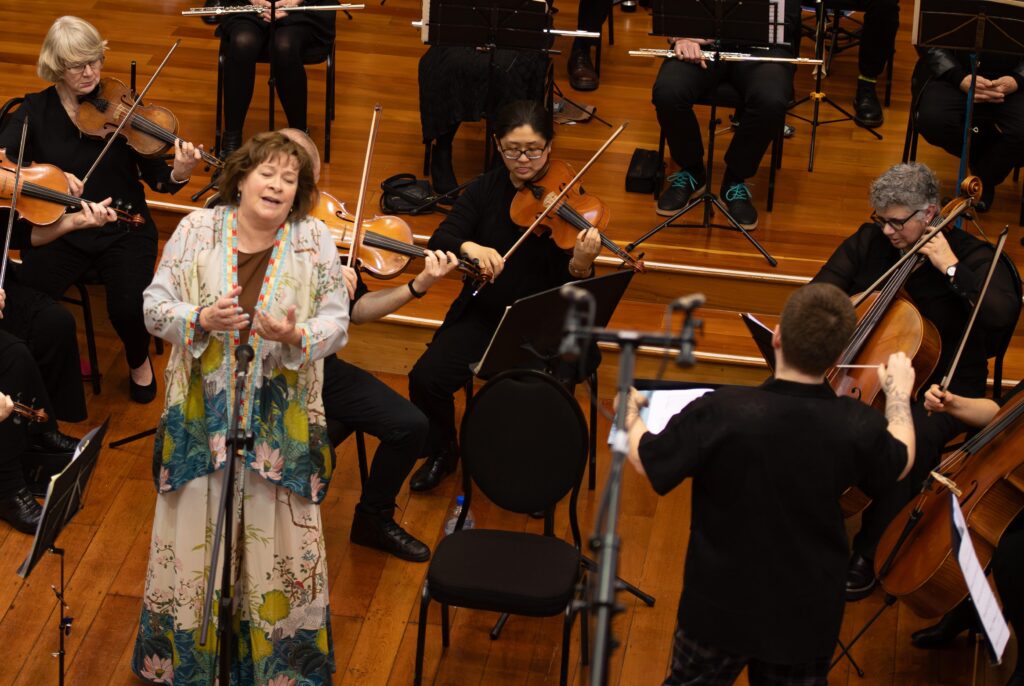 Anna Gawn performs Ross Harris’s Klezmer Suite with Rachel Hyde conducting the Wellington City Orchestra
Anna Gawn performs Ross Harris’s Klezmer Suite with Rachel Hyde conducting the Wellington City Orchestra Act One: Wade Kernot (Coach), Manase Latu (Count Ory), Moses MacKay (Raimbaud), NZ Opera Chorus – photo credit: Lewis Ferris
Act One: Wade Kernot (Coach), Manase Latu (Count Ory), Moses MacKay (Raimbaud), NZ Opera Chorus – photo credit: Lewis Ferris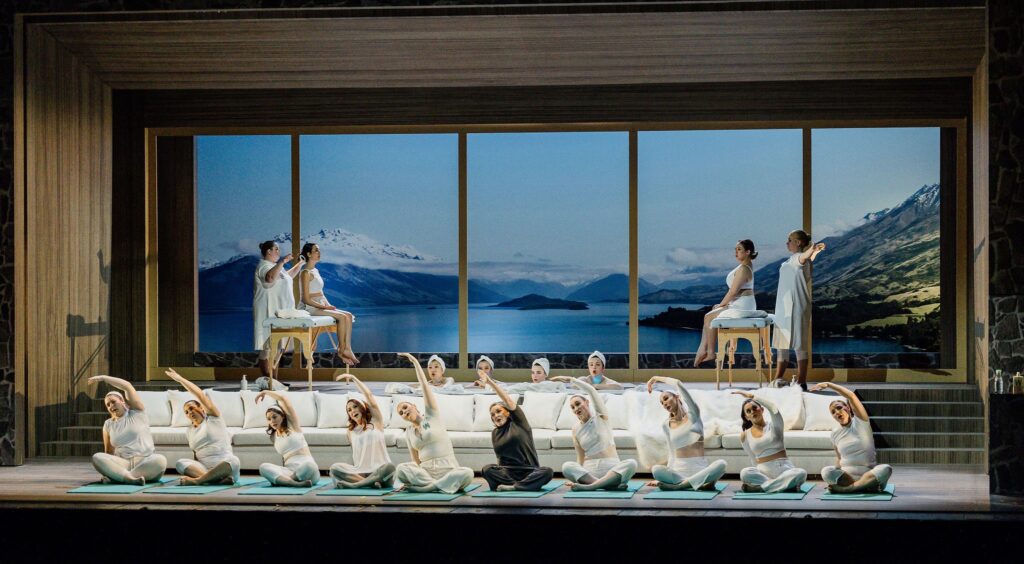 Le Comte Ory – Act Two (beginning) – NZ Opera Chorus, with Emma Pearson (Countess Adele), Tayla Alexander (Alice) and Andrea Creighton (Ragonde)
Le Comte Ory – Act Two (beginning) – NZ Opera Chorus, with Emma Pearson (Countess Adele), Tayla Alexander (Alice) and Andrea Creighton (Ragonde)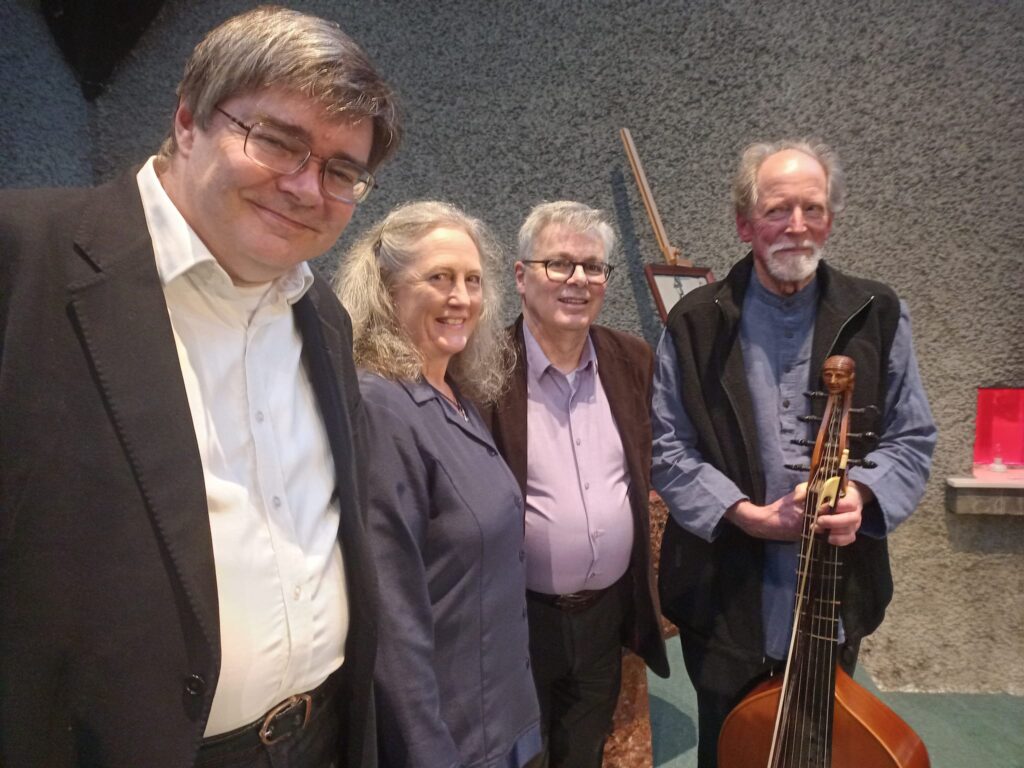 David Morriss (bass), Pepe Becker (director, soprano), Douglas Mews (keyboards), Robert Oliver (bass viol)
David Morriss (bass), Pepe Becker (director, soprano), Douglas Mews (keyboards), Robert Oliver (bass viol)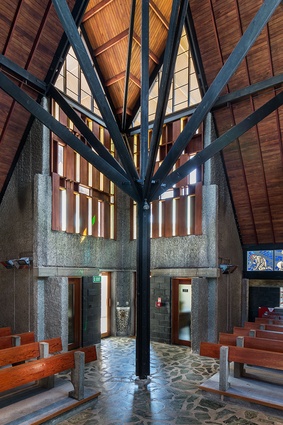 Futuna Chapel, Karori
Futuna Chapel, Karori
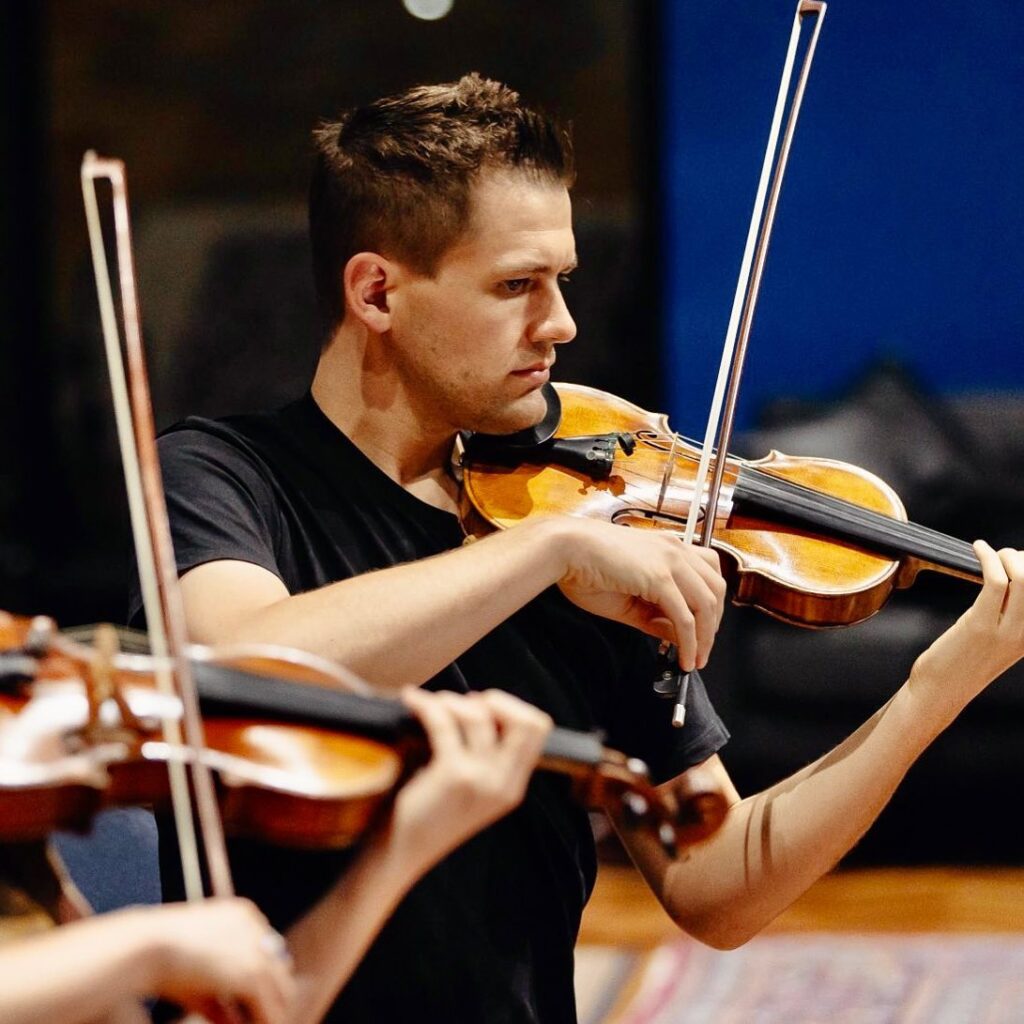 Peter Clark
Peter Clark